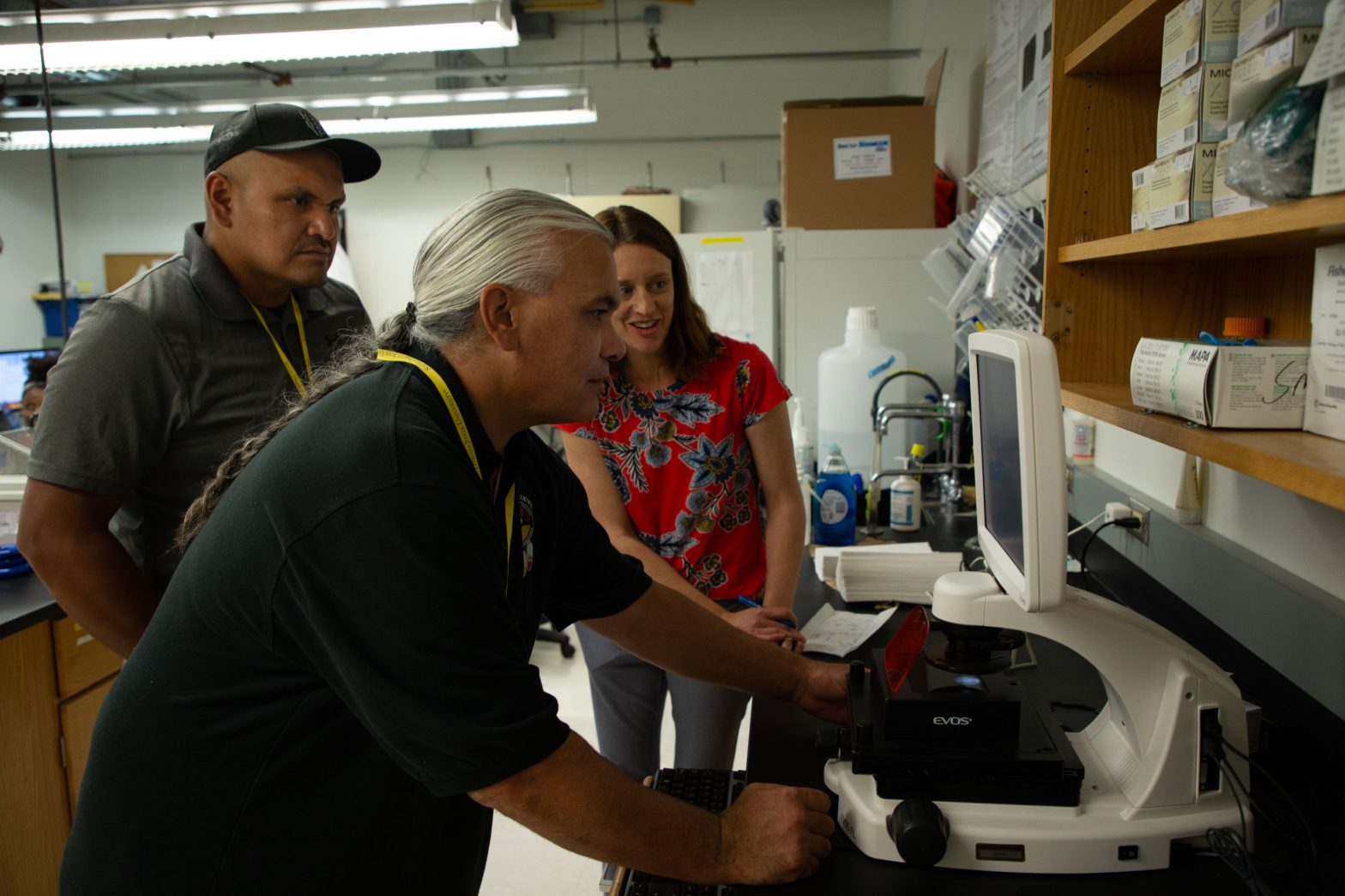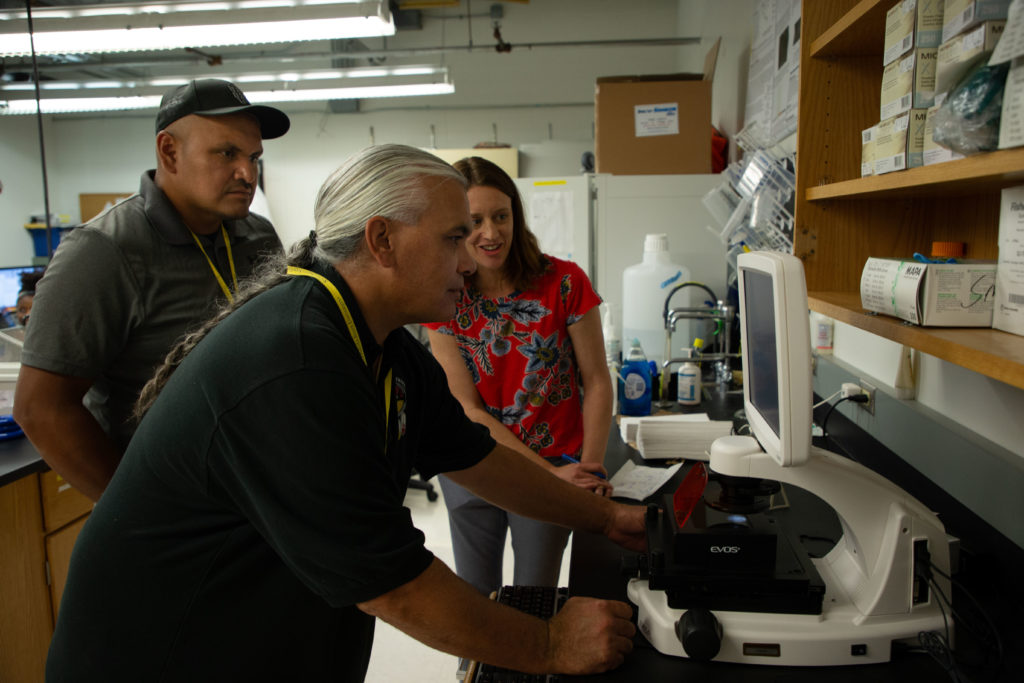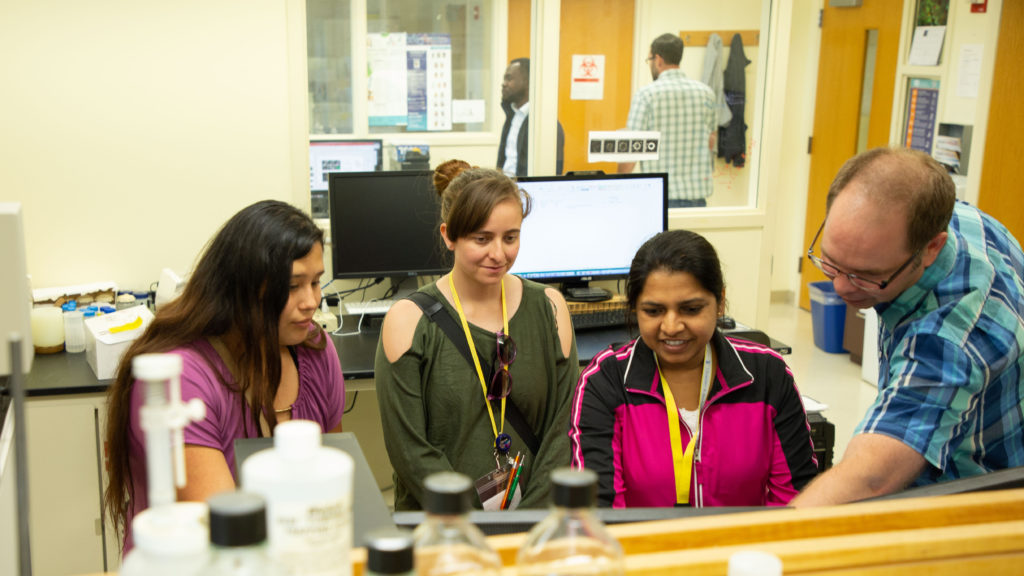Sinte Gleska Students Experience Research at SDSU

“Come try it out—this is what we do.”

These words from South Dakota State University researchers are helping students from Sinte Gleska University in Mission see what’s possible through their research. And that’s exactly what the Sinte Gleska students’ adviser, Dana Gehring, had hoped would happen during their two-day BioSystems Networks and Translational Research (BioSNTR) center-sponsored research experience.
All five Sinte Gleska students who visited South Dakota State are working on funded research projects, explained Gehring, who heads the SGU computer and environmental sciences department. BioSNTR Program Manager BreeAnn Brandhagen and BioSNTR Senior Secretary Courtney Jones worked with Gehring to tailor the visit to her students’ interests.
Brandhagen said, “The ultimate goal is to give the students an opportunity to learn about research, equipment and capabilities beyond those available at their schools.” This is the first time BioSNTR has sponsored this event to bring students from the tribal colleges to campus, but Brandhagen and Jones are already making plans for future visits based on the students’ positive experience. BioSNTR hopes to create more opportunities like this for students at not only tribal colleges, but also smaller primary undergraduate institutions, who may not have access to some equipment or techniques.
Joseph Hacker, who is finishing an associate degree in nursing, said, “The nursing field is practical, but I’ve always loved biology and environmental sciences.” He is doing water quality research on the Little White River, Spring Creek and a natural spring in Todd County. “I’m looking at chlorophyll, E. coli, pH, ammonia and turbidity in these water bodies before bison are introduced,” he explained.
Junior environmental science major Darian Running Horse is analyzing the soil and Lester Kills The Enemy is doing an animal survey, while another SGU student is doing an arthropod survey. The baseline data that these four undergraduate researchers are gathering will be part of a 10-year study assessing the impact of bison on the ecosystem, according to Gehring. Her goal is to get other universities involved in the project.
Brandhagen said, “Successful collaborations are mutually beneficial to both parties. We hope that this is a way to get conversations started, meet people, talk about research and get some new ideas that SGU and SDSU can build on.”
Hacker added a visit with SDSU Water and Environmental Engineering Research Center (WEERC) Director

Chris Schmit. “He gave me some pointers on other things to test for,” said Hacker, who plans to send water samples to SDSU for further analysis. He also got some ideas on soil analyses to share with Running Horse.
“It is helpful to see the atmosphere at a larger university. The staff and faculty are very courteous and let us participate in their labs and operate some of the equipment,” Running Horse said.
Hacker agreed: “It was an awesome experience, being in a lab and seeing what they are doing.” When Assistant Professor Natalie Thiex explained her research to determine which genes control how cells drink, the students were able to manipulate the microscope to see the white blood cells the researchers are studying.
In Associate Professor Adam Hoppe’s lab, the students examined fluorescent images that help the researchers examine how immune cells target viruses. Assistant Professor Qin Ma’s work mapping gene expression intrigued computer science major Pauline “Stormie” Jackson. “A lot of people are using scripting languages to analyze their data—that intrigues me. I can use my degree in more than just one area. It was refreshing.”
Jackson, who completed an associate degree in human services and is working on a bachelor’s in computer science, visited SDSU several times exploring undergraduate studies, but now she’s focused on the graduate school. Jackson and SGU biology major Maliesha Bear Heels have been collecting mosquitoes to monitor West Nile virus in the Mission area as part of the South Dakota Department of Health surveillance program.
“Through this experience, the students can see how the pieces fit together,” Jones said. Next year Brandhagen and Jones hope to draw up to 12 students from all three tribal colleges. When it comes to involving university researchers, Brandhagen said, “Our goal is to continue to expand the program and grow participation to represent even more of the research at SDSU.”
 National Science Foundation RII Track-1 Project:Expanding Research, Education and Innovation in South Dakota
National Science Foundation RII Track-1 Project:Expanding Research, Education and Innovation in South Dakota